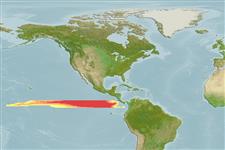Teleostei (teleosts) >
Myctophiformes (Lanternfishes) >
Myctophidae (Lanternfishes) > Diaphinae
Etymology: Diaphus: Greek, dis, dia = through + Greek, physa, phyo = to beget, to have as offspring (Ref. 45335); similis: From its similarity to D. trachops and to a lesser degree, to D. suborbitalis (Ref. 7454).
Environment: milieu / climate zone / depth range / distribution range
Ecology
Marine; bathypelagic; depth range 0 - 631 m (Ref. 7454). Deep-water; 10°N - 4°N, 119°W - 87°W
Eastern Central Pacific.
Size / Weight / Age
Maturity: Lm ? range ? - ? cm
Max length : 7.2 cm SL (female)
Short description
Identification keys | Morphology | Morphometrics
Dorsal soft rays (total): 14; Anal soft rays: 15 - 16; Vertebrae: 34 - 36. Small patches (scales) of luminous tissue at certain photophores (although subject to erosion, these luminous scales are quite persistent and are evident on specimens that have lost all body scales and most scale pockets).
Body shape (shape guide): elongated; Cross section: compressed.
Life cycle and mating behavior
Maturity | Reproduction | Spawning | Eggs | Fecundity | Larvae
Paxton, J.R., R.J. Lavenberg and C. Sommer, 1995. Myctophidae. Linternillas. p. 1315-1321. In W. Fischer, F. Krupp, W. Schneider, C. Sommer, K.E. Carpenter and V. Niem (eds.) Guia FAO para Identification de Especies para lo Fines de la Pesca. Pacifico Centro-Oriental. 3 Vols. FAO, Rome. (Ref. 9325)
IUCN Red List Status (Ref. 130435: Version 2025-1)
Threat to humans
Harmless
Human uses
Tools
Special reports
Download XML
Internet sources
Estimates based on models
Phylogenetic diversity index (Ref.
82804): PD
50 = 0.5000 [Uniqueness, from 0.5 = low to 2.0 = high].
Bayesian length-weight: a=0.00759 (0.00328 - 0.01756), b=3.02 (2.83 - 3.21), in cm total length, based on LWR estimates for this Genus-body shape (Ref.
93245).
Trophic level (Ref.
69278): 3.1 ±0.3 se; based on size and trophs of closest relatives
Resilience (Ref.
120179): High, minimum population doubling time less than 15 months (Preliminary K or Fecundity.).
Fishing Vulnerability (Ref.
59153): Low vulnerability (10 of 100).
🛈
